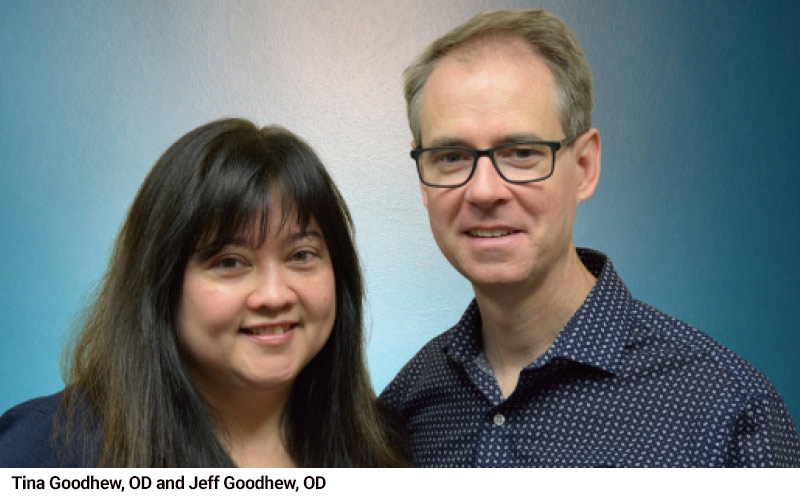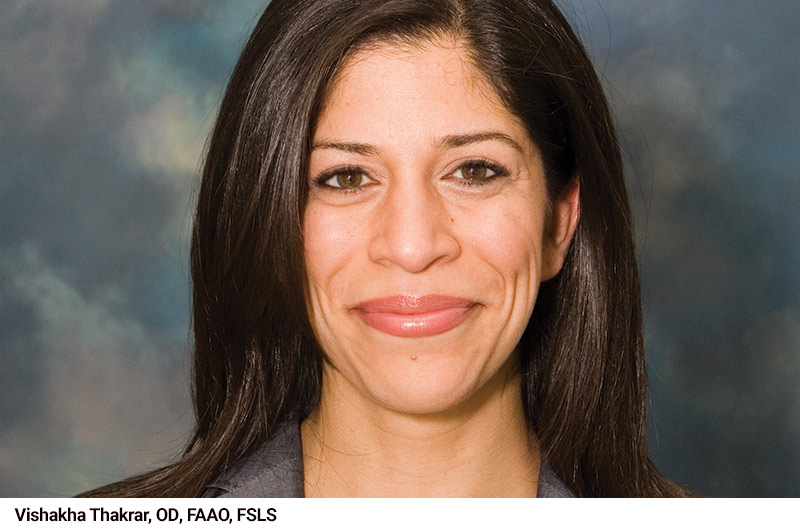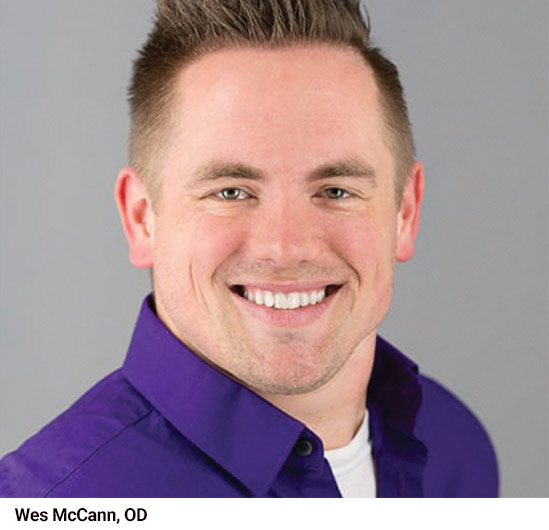
By Sarah McGoldrick
Myopia has reached epidemic proportions. Once seen as an eye condition mainly experienced by children, it now affects approximately 25 percent of a quarter of young adults. A 2022 report in “Front Public Health, Prevalence and Risk Factors of Myopia in Young Adults: Review of Findings From the Raine Study” (ncbi.nlm.nih.gov/pmc/articles/PMC9092372) found that by age 28, myopia prevalence had increased to more than 33 percent. As people lead a more digital lifestyle and perform more near tasks, this number is expected to continue to increase globally. A study in “Ophthalmology, Global Prevalence of Myopia and High Myopia and Temporal Trends” from 2000 through 2050 (pubmed.ncbi.nlm.nih.gov/26875007), reports that nearly 50 percent of the world population will have myopia by 2050, of which 938 million people will have high myopia.
Without adequate treatment, myopia can lead to a host of other serious vision problems, including myopic macular degeneration (MMD), glaucoma, cataracts and retinal detachment. Treatment options vary from country to country, with both spectacle lenses and contact lenses available in many parts of the world.
In the United States, the Food and Drug Administration (FDA) has approved myopia control contact lenses such as CooperVision’s MiSight and Johnson & Johnson Vision’s Acuvue Abiliti. Yet the agency has yet to approve any myopia control spectacle lenses. (The FDA has granted Essilor’s Stellest spectacle lenses the Breakthrough Device designation. The FDA’s Breakthrough Devices Program is intended to provide patients and health care professionals with timely access to medical devices that offer more effective treatment or diagnosis of life-threatening or irreversibly debilitating diseases or conditions by speeding up their development, assessment and review.)
In Canada, both contact lenses and spectacle lenses are approved for treating myopia. Canadian ECPs report having significant success with a variety of products. 20/20 spoke with four Canadian optometrists about their experiences prescribing and dispensing myopia control lenses. Their observations provide a window for U.S. practitioners who wish to glean some insights of their own as they await FDA approval of myopia control spectacle lenses.

Tina Goodhew, OD, and Jeff Goodhew, OD, own Abbey Eyecare in Oakville, Ontario. In addition to their regular practice, they run a large myopia management practice that utilizes several lens options for patients.
“We currently use Hoya MiYOSMART, SightGlass, Zeiss MyoCare and Essilor Stellest. The scientific data has shown a significant reduction in refractive error and axial progression with these lenses,” explains Dr. Tina Goodhew. “I have been using MiYoSmart and SightGlass for the longest period of time, and clinically, I have seen similar results to the published data.”
Dr. Goodhew says that when discussing options with patients, she leads with SightGlass. “It is the only lens studied on 6-year-olds, and we have seen excellent clinical results with treating children with this design. However, the effectiveness of the MiYOSMART, Stellest and MyoCare lenses is also strong for children, so we also use these lenses as our initial recommendations.”
She adds that the experience with prescribing these lenses has been “outstanding,” and they have seen a notable myopia and axial length reduction clinically. “Kids have adapted to the lenses very well. Parents have been quick to understand the use of and importance of this technology for their children. Prescribing myopia control ophthalmic lenses has been a game changer in the myopia management space.”
Prior to the introduction of these technologies, Dr. Jeff Goodhew notes they were able to prescribe contact lenses and atropine for myopia management. However, for some younger children, parents were hesitant about the concept of putting something in their child’s eyes. “This issue does not exist with myopia control glasses. We can more easily put children in myopia management therapy than we ever have before because parents easily accept these devices for their children,” he adds.
The overall results of using myopia lenses have been positive, with the office monitoring children every six months to check for refractive errors and axial length. Dr. Goodhew says that in most cases, there is a significant reduction in the progression of myopia and axial length. “I have seen some cases where the refractive error change has halted after prescribing these lenses,” he notes. “The vast majority of patients are able to adapt to the lenses immediately. The only time that I have seen issues is when children have sensory issues or when they are allowing the lenses to slip down their nose and essentially only look through the treatment area. Even in these situations, adaptation complaints are rare.”
The Goodhews report that treatment areas of each lens are highly effective, noting that the MiYOSMART lens peripheral defocus is accomplished through the use of defocus segments in the periphery of the lens. Each of these segments is +3.50 D with the space between the segments while still carrying the distance power, allowing the child to see clearly peripherally as well as centrally. Meanwhile, they say the Stellest lens design utilizes lenslets in concentric rings to accomplish a volumetric myopia defocus, which is very effective in the treatment of myopia. “The child is also able to see the distance between these lenslets,” says Dr. Tina Goodhew. “Zeiss MyoCare uses cylindrical annular refractive elements to introduce a peripheral add power. Interestingly, studies have shown that a different peripheral add power is optimal for younger children ages 7 to 9 versus older children ages 10 to 12.”
She adds that the SightGlass lens has a completely different treatment design where the contrast has been reduced peripherally. Through the use of Diffusion Optics Technology (DOT), a technology that uses thousands of microscopic light scattering elements, contrast signaling is reduced. “This treatment design is also highly effective and has been studied on children as young as 6 years old.”

At Vaughan Vision Care in Vaughan, Ontario, Vishakha Thakrar, OD, FAAO, FSLS, and her team put innovation first to ensure that patients get the best treatment options. Thakrar was one of the first eye doctors in Canada to utilize myopia control therapies. She believes putting the needs of the patients first is key to clinical efficacy in the areas of myopia control. She noted this allows her office to achieve the best outcomes for patients. “One needs to look at efficacy in both reduction in spherical error and axial length; they are not always correlated. Many of the lenses such as MiYOSMART, MyoCare and Stellest, I believe fall into this category with nearly equal efficacy,” she says. “Secondly, what is best for my practice? I prioritize collaborating with companies that engage with independent eyecare professionals. It’s important to me that these companies assist my team with training, provide educational resources for my patients and importantly, support independent eyecare without aligning with large corporate entities that could potentially undermine the value of independent practices.”
Dr. Thakrar strongly endorses the Canadian Association of Optometrists’ stance that myopia control is a standard care practice. She believes in broadening patient access through independent eyecare providers rather than through large discount retailers offering the same products at significantly lower prices. “Contact lens manufacturers have exemplified this approach for years by offering rebates through independent eye-care professionals, which reduces costs for consumers and enhances access to these products in independent eyecare,” she notes. “I feel the true winner in this category is Zeiss with their MyoCare lens, as they have not positioned themselves in corporate big-box entities with a strategy that fosters the undercutting of independent eyecare.”
Dr. Thakrar adds that it is also crucial for practices to consider what is most advantageous for the industry. She says this involves identifying which company is effectively promoting the integration of myopia control products with the service of closely monitoring and managing patient progression. “It’s important to recognize who is best positioning patients for success by facilitating access to both quality products and expert management of their myopia, including comprehensive monitoring and assessments,” she says. “Placing these products in large-scale retail environments risks severing this vital connection between product and service, which can be particularly harmful in a relatively new field like myopia control. Given the extensive education required about both the condition itself and the products used to manage it, separating the two can lead to significant errors and misunderstandings.”
She notes that in her opinion, Zeiss MyoCare has taken the lead on this as they have not aligned themselves with mass retail, adding that overall, they have had excellent success with the MyoCare lens. “Patients adapt extremely well; aesthetically, the lenses look great on the patient, and we are using a high-quality lens company. Zeiss lenses were used to document the first moon landing and are used in the Google Earth satellites.”
Response to treatment has also been good, according to Dr. Thakrar, with very minimal progression in patients. She says patients adapt nearly as quickly as they do with regular single vision lenses, adding that the clinical evidence supports the efficacy of MiYOSMART, MyoCare and Stellest as leaders.

Wes McCann, OD, is a noted expert in myopia management and treatment. At his London, Ontario-based clinic Central Optometry, he has worked with countless children and adults to help them find the right solution. His education-focused approach means both the parents and children are part of the treatment journey. Dr. McCann says his team currently offers three options: Zeiss MyoCare, Essilor Stellest and SightGlass. “We did use Hoya MiYOSMART in the past but feel that lenses that provide a treatment zone which encompasses the entire periphery of the lens are apt to work better than lenses that have a limited treatment zone size,” he says. Dr. McCann says he is happy with the ease of prescribing. He says success is based on the ability to specify monocular OC heights and monocular PDs and try to have pupils centered in the frame as much as possible. “The results have been fantastic. We have noted a significant slowdown in the progression of myopia with all three lenses. Zeiss MyoCare and Essilor Stellest lenses appear to work on par with each other. This makes sense as they are both based on peripheral defocus theory, and both lenses provide a treatment zone that spans the entire periphery of the lens.”
Dr. McCann notes that SightGlass has had the best results with children between the ages of 6 and 8, adding the mechanism of action for SightGlass is contrast reduction theory, which allows his team to try a different lens if the first choice does not give them the control they desire. “We have never had a non-adapt, and most children adapt to their lenses within the first week. Children are highly adaptable.”
To ensure they were moving in the right direction when it comes to treatment options, the office conducted a one-month survey on all children who began wearing myopia management lenses when they first began describing them. Dr. McCann says they realized the surveys were not necessary as everyone had adapted to the lenses, saw clearly and were happy with their performance. “Having a lens with a treatment zone that spans the entire periphery is more effective. This is because the child will not be able to ‘look above or around’ the treatment zone. These lenses work, but they must be worn full time (12 hours a day) to be most effective. We have had cases where a child stopped wearing their glasses full time, and the myopia control fell drastically.”
Dr. McCann adds that the best results are a team effort on the part of the eyecare provider, parents and children. “Children must wear their glasses full time and look through the treatment zones for the most effective myopia control,” he concludes.
Sarah McGoldrick is a freelance writer who specializes in optical subjects. She is based in Toronto, Canada.













